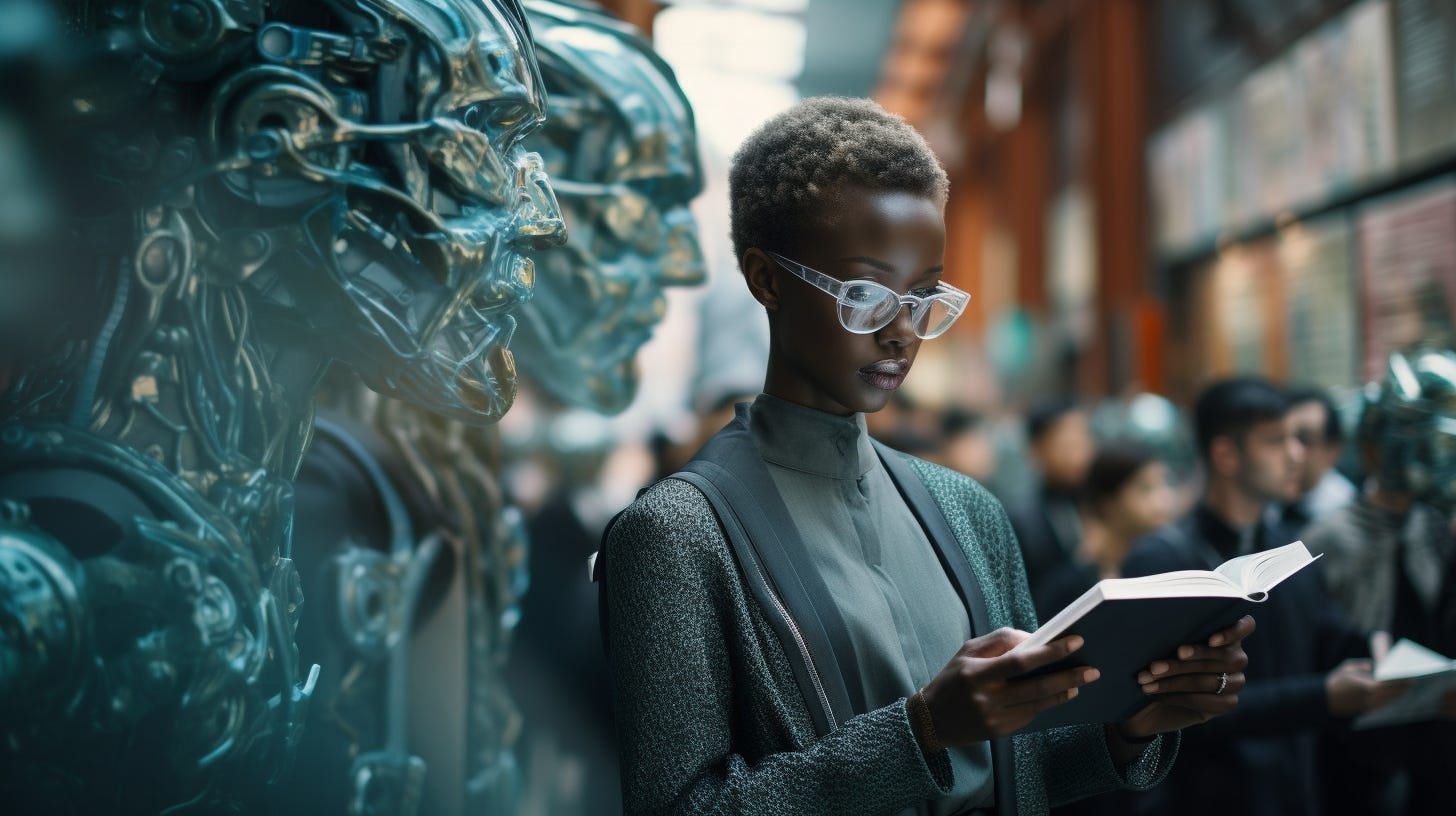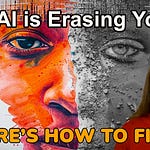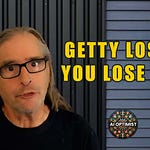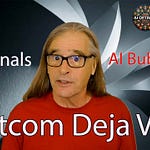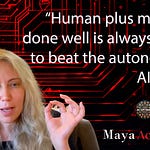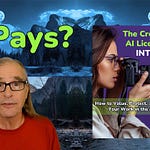Remember how easy creative life was just 2 years ago. Creators wrote books, paintings, and pictures; curators asked permission to use parts in their work, with payments if sales were made.
Out with the Old, In with the GenAI: The Transformation of Copyright
A creator and a curator shape how others experience the world.
A creator by producing new works of art, literature, music, etc., and a curator by prompting and presenting works of art, literature, music, etc., for an audience using GenAI.
The world of copyright laws looks like a grand old library. Each book is a masterpiece hiding behind glass cabinets with stern lawyers metering out usage.
GenAI looks more like a shape-shifting librarian who opens the books while whipping up new chapters, alternative endings, and entirely new novels!
Is copyright law a Luddite position in the age of AI?
What is creative content - should it be copyrighted - and how do we keep original works going so AI creates better results instead of models collapsing into mediocrity and stagnation?
Old Rules, New Tools: How GenAI is Rewriting the Copyright Handbook
“Copyright law is not just antiquated but soon irrelevant. If we get to the point with unlimited real-time content creation, there is no need to steal anything, or try to hold on to the finite amount of contact in libraries….
Copyright is sold to us to protect the artist. I hold that it’s a way to package art for sale to a mass audience and not needed.”
Warren Whitlock

Pros
Ingenuity Boost: Getting rid of copyrights leads to an explosion of creativity. Removing legal barriers allows for rapid mixing, change, and distribution of existing content.
Ease of use: A lack of copyrights makes content accessible to everyone. This democratizes knowledge and creative works, providing more opportunities while removing limits.
Less Lawyers’ Fees, More Creative Payments: Legal disputes for copyright infringement disappear. All save costs from legal advice, litigation, and copyright registration.
Rapid Iteration: New versions of a creative work appear rapidly, pushing quality through collective effort.
AI Enhancement: AI-generated work will not replace human creativity but enhance it.
Cons
Loss of Income: Copyright law provides a revenue stream for creators. Monetization is undermined, though only a few people currently monetize their creations.
Commodity-driven content erodes AI: It may focus creators only on what they can sell instead of inspiring originality, eventually undermining AI quality.
Quality Concerns: Copyrights are an incentive to invest time into creating high-quality works. Without incentives, the quality of content may decrease. Why bother?
Groupthink undermines creative ventures: Anyone can blend anything into their work without copyrights. Individual creativity may need to be noticed.
GenAI and the Future of Creative Ownership: Are Artists Being Written Out?
The Copyright Protects My Original Work
“AI stole from artists in the first place. In some pieces, you can even see an original artist’s signature incorporated into the work. AI isn’t creating new work, it’s taking pieces of existing works and putting them together....
I don’t think AI is a bad thing. I do think that the way it’s been built is. Some of my work was on sites that have belatedly announced that they allowed all artworks to be scraped by AI bots.
For some of mine, I probably would have given permission, if asked. For others, I would have denied it, but I never had the chance to make that choice.
Some sites do say they’re training AI with your creative works but hide it in their settings. Adobe does this. You have to go into settings and change your permissions if you don’t want your work scraped.”
Te-ge Watts Bramhall
“The success and profitability of OpenAI are predicated on mass copyright infringement without a word of permission from or a nickel of compensation to copyright owners.”
Franzen, Grisham and Other Prominent Authors Sue OpenAI
Pro Copyright: Preservation of Human Ingenuity and Ownership
Incentive for Originality: Copyright rewards original creators with exclusive rights. This motivates artists to invest time and effort, resulting in high-quality creations.
Quality Over Quantity: With copyright security, artists focus on quality instead of mass-producing content. Exclusivity ensures an economic incentive for intricate, thoughtful work.
Protection Against Model Collapse: In a system that relies solely on AI for creative output, there’s a risk of “model collapse,” where AI-generated works degrade in quality due to the loss of original human input. Copyrights ensure a continuous supply of new, high-quality, human-created content for AI systems to learn from.
Cons of Pro Copyright
Access Inequality: Copyrighted material is expensive or difficult to access, stifling the spread of knowledge and creativity.
Limiting Inspiration: Copyright restrictions block the remixing or adaptation of existing works, limiting new creations built on previous ones.
Old Laws, New Rules: Copyright law is outdated for the new era of GenAI. Old laws will limit access to AI content while paying copyright owners is challenging.
A 2-tier system will clearly develop, with high-quality content owned by major companies like Getty Images licensed at a higher pricing tier than Public Domain content, available to everyone.
Unasked and Uncredited:
The Ethical Dilemmas of AI Scraping Content without Permission
Much of the content scraped for AI was taken from social media, sites like Wikipedia and Reddit, some websites, scientific articles, and collections gathered with permission.
Much was collected without asking; you can see in images that sometimes an artist’s signature will appear.
What do we do with content that didn’t get permission?
Ownership – who owns what now? Is there any way to tell what content is in the AI black box?
Reset – if copyright lawsuits are successful, will the LLMs have to start from the beginning?
This would be a massive blow to current AI, and I’m not sure it’s feasible.
Using Creative Content for Training Data without permission
AI training is based on existing creative content, sometimes without consent.
It’s like a chef using someone else’s secret recipe to create a new dish and claiming it as original. This blurs the boundaries of ownership and ethics.
Permission – will AI be made opt-in, expressing authorization, rather than opt-out, removing consent?
Transparency and Choice
Clear communication is needed from platforms like Reddit or Wikipedia, allowing AI scraping. Even if permissions are hidden within settings, as with Adobe, the duty to opt out is unfairly placed on the creator.
It’s like being automatically added to a digital library you didn’t choose, with the burden on you to drop out.
Historical Digital Theft and the New AI Game
The Internet includes a longstanding struggle against unauthorized use of creative works.
The evolution of AI adds a new layer to this challenge. It’s like having a neighbor steal from you, only to find that a more sophisticated thief is quietly stealing without you knowing.
Legal Threats
Ongoing lawsuits, if successful, could wipe out all AI-trained data violating copyrights. This could serve as a reset button, establishing new ground rules for AI training.
Solutions and Next Steps
Retroactive Permissions and Royalties: It’s possible to seek retroactive permissions and possibly royalties for those whose work was used without consent. Not likely and maybe impossible.
Opt-in Models: Platforms adopt a transparent, opt-in model for content creators willing to use their work for AI training. For example, OpenAI has code that can block its bot from accessing the content on your website. However, social media is still wide open and hard to protect.
Legal Precedence: The lawsuits could set important precedents. If AI companies are found to be in violation of copyright laws, this forces a rethinking of how AI training is done.
AI Divides into 2 Tiers –
High-Quality Copyright Content and Public Domain/Creative Commons
While AI is changing the world, it can’t shift copyright ownership and rights.
The idea that anyone can go into a free or low-cost tool and access IP like Star Wars characters is both promising and threatening to companies who thrive off paid access to that content.
There are new worlds of AI content developing, one expensive and one based on what we call GenAI:
Expensive and high-quality paid content – like Star Wars or Getty Images, for example – with a licensing fee and attribution to pay for access.
Digital watermarks are applied to content with fees based on the percentage used, access, recurring payments, etc. It will be an ongoing negotiation at the most significant levels of content ownership, like movies and major media.
Creative Commons Licensing: Offer all creators the right to apply a Creative Commons license, which protects their work, provides attribution when used, and pays where appropriate.
Current public domain and permission-based content within GenAI is affordable for the rest of us. This includes attribution for works if people apply and place the watermarks in for some compensation and control, though limited to an amount that reaches a minimum for payment.
Consider adding an incentive for free access to GenAI for creators at a reduced or freemium in exchange for creating original content.
What does this new world look like to you? How should it work?

1. Creator Copyrights: Traditional Copyright for Human-Generated Original Content
The existing model for human-authored works without AI involvement is covered by copyright law. Creators hold exclusive rights to their works, including distributing, replicating, and monetizing. It’s like having private content where only the original owner has the key.
How it Works:
Registration with a copyright office.
Artists have the sole authority to license or sell their works.
Infringements are punishable under existing copyright laws.
2. Curator Copyrights: Co-Creation Copyright between GenAI and content curators.
The Curator Copyright addresses both human artists and AI as co-creators.
Credit and royalties are split between the human curator and the AI’s developers or owners.
The definition of a curator would involve prompts and other activities people enter into GenAI to co-create content. A curator builds the framework and ideas via prompts, and GenAI creates the content.
How it Works:
A new legal framework defines “co-creator” rights concerning AI.
The work carries a dual attribution, like a scientific paper with multiple authors.
Royalties are divided based on a pre-agreed percentage between the human curator and the AI’s developers or owners.
3. Smart Contracts for Monetizing GenAI Content – Beyond Copyrights
Smart contracts automatically enforce rules around the use and monetization of AI-generated content. These contracts could be built on blockchain technology, making the agreements transparent and self-executing.
How it Works:
The smart contract specifies conditions under which the AI-generated content can be used, modified, or monetized.
If there is no smart contract, as in most cases, the content is in the Public Domain.
When a user interacts with the content outlined by the contract, a predefined set of actions and/or payments automatically occur. For instance, a small fee is paid directly to the AI’s owner.
Unlike traditional contracts, these are self-executing and don’t require agents.
Key Takeaways
Different types of creations require other legal frameworks:
Creator Copyright is for purely human-generated works, offering complete control.
Curator Copyright recognizes human and AI contributions, sharing credit and potential revenue.
Smart Contracts allow for dynamic and automated monetization of AI-generated content outside copyrights.
Each model has its unique benefits and challenges but offers a pathway for preserving human creativity and accommodating the role of AI in content creation.
The Case for Copyrighting AI-Generated Art and Content
AI doesn’t operate alone, despite collaging together ideas from various sources. AI’s capabilities are initiated, guided, and fine-tuned by a human, giving specific direction to the creative process.
Without humans, there would be no AI-generated content. Without AI, we couldn’t quickly enter prompts and create content.
This interdependency is vital, especially since AI benefits from original ideas and content. It doesn’t create anything original.
If people just used AI and stopped creating unique works, what’s called a “model collapse” would happen, as the quality of AI decreases if it relies only on its own input and not on human ingenuity.
The Idea of Co-Pilots in Art Creation
As co-pilots, AI and humans are a powerful combination with unique skills—humans share the creative vision, and AI brings this to life with computational power.
We learn from the AI’s outputs, refining creative instincts while AI adjusts algorithms based on human feedback. It’s a symbiotic relationship evolving over time.
Five Ways to Adapt Legal Rules
Expand Legal Rules Beyond Human Authorship: The legal definition of ‘author’ could include humans and AIs as co-creators entitled to joint copyright ownership.
New Norms for Originality: Establish new measures of originality in AI-generated content. Evaluate the extent and quality of human prompts in guiding the AI.
Copyright length depends on the act of creating: Introduce different durations of copyright protection based on the extent of human-AI collaboration. There is a difference between human-created content and that done in collaboration with AI.
Digital Credit: Develop fixed digital signatures proving the ownership of AI-generated art, including the level of human involvement.
International Copyrights: Make global copyright rules because AI is international.
Measuring and Validating Originality in AI-Human Collaborative Art
Evaluate originality by measuring the influence of people and AI in content creation.
For example, consider the extent of the AI’s algorithmic difference from its training data influenced by human involvement.
AI content experts evaluate the uniqueness and creativity of the work, focusing on the interpretative choices made by the human creator.
Creating art at the intersection of human imagination and artificial intelligence deserves its own category of legal protection.
Explainability and Interpretability of AI
Explainability and interpretability of AI systems become crucial when measuring and validating originality.
When an AI system’s decisions can be traced and when we can comprehend how it made creative choices, it strengthens the measures for originality.
For instance, understanding the AI’s “attention focus” or the features the model deems relevant allows a view into how the human input influences those choices.
Given its training data and the human-guided alterations, it provides a framework to gauge the uniqueness of the AI’s output.
Quantifying Human Input
How much a person prompts, edits, and adapts a work may give a quantifiable measure. A session involving 100 prompts may show a more profound human enhancement than one of 10 prompts.
However, the focus should also be on the quality of the input. For example, a single, insightful prompt taking AI’s creativity in a unique direction could be more indicative than 100 trivial updates.
The Curator Copyright for Joint Creation
The development of AI copyright laws must be carefully considered to balance the interests of creators, users, and the tech industry.
If curator copyright for AI-human joint content creation is created, there are several ways to make it work for both sides:
Revenue Sharing: The AI company and humans enter revenue-sharing agreements for any income generated.
License Fees: The AI company charges a license fee for generating copyrighted material. This could be a one-time or recurring charge based on sales activity.
Rule Setting: The AI company sets guidelines for joint copyright. For example, specify the minimum or maximum prompts required or levels of customization outside of AI (like editing in Photoshop or rewriting an article).
Partial AI Rights: The AI company retains partial rights to the artwork and shares in sales, reproductions, or variations.
Smart Contracts: On blockchain networks, automatically distribute royalties between humans and AI companies based on agreed-upon rules.
Can AI and human artists co-author the next chapter of creativity, or will they be in a courtroom drama?
Stealing content has been a problem for years on the Internet – is AI doing the same thing, or is this new?
Few Ideas to Keep Us Creating and AI Growing
Blockchain for Credit – Like Creative Commons but automatic: Instead of copyrights, a blockchain ledger could keep track of who first created a piece of work. Although the result could be freely used and modified, credit is given to the original creator.
Freemium Model: Creators offer free basic versions of their work while charging for premium versions. This could maintain economic incentives without stifling creativity.
AI as a Collaborative Tool: Instead of replacing human artists, GenAI serves as a tool for enhancing human creativity.
Suddenly, the old game of swiping content goes high-tech, and this new player turns heads and raises eyebrows.
While GenAI is busy creating its own Mona Lisa or penning sequels to “Oppenheimer,” it’s doing so by sampling from countless artists without asking for permission.
Do the original creators—the artists, writers, and thinkers creating the content— own the rights to their work in this AI-driven future?









